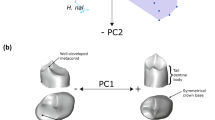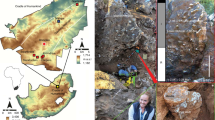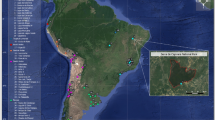Abstract
Data obtained from ramapithecine specimens found in Asia, Africa and Europe1–6 have suggested the existence of two major subgroups, Ramapithecus and Sivapithecus, with Ramapithecus having pre-human status7,8. Recently, however, it has been proposed that the fossils all belong to a single group, Sivapithecus, which is more closely related to the apes, in particular the orang-utan9–13. Here we analyse data from a series of similar fossils which have been found in late Miocene coalfields in Lufeng, Yunnan Province, China14–16. These include a number of almost complete jaws and five partial skulls which are more complete than any others so far known17–21. A statistical analysis of the overall dimensions of the large number of teeth included in these finds shows that the differences between the groups previously assigned to Ramapithecus and Sivapithecus are greater than those found between the sexes in the most sexually dimorphic of the living great apes. Within the groups the distribution is bimodal and we suggest each group contains sex subgroups.
This is a preview of subscription content, access via your institution
Access options
Subscribe to this journal
Receive 51 print issues and online access
$199.00 per year
only $3.90 per issue
Buy this article
- Purchase on Springer Link
- Instant access to full article PDF
Prices may be subject to local taxes which are calculated during checkout
Similar content being viewed by others
References
Lewis, G. E. Am. J. Sci. 22, 161–181 (1934).
Leakey, L. A. Mag. nat. Hist. 13, 689–696 (1962).
Simons, E. Early Hominids of Africa 543–566 (Duckworth, London, 1978).
Kretzoi, M. Nature 257, 578–581 (1975).
Von Koenigswald, G. H. R. Proc. K. ned. Akad. Wet. B75, 385–394 (1972).
Andrews, P. & Tobien, H. Nature 268, 699–701 (1977).
Simons, E. & Pilbeam, D. Folia Primatol. 3, 81–152 (1965).
Simons, E. Scient. Am. 236, 28–35 (1977).
Smith, R. J. & Pilbeam, D. Nature 284, 447–448 (1980).
Lipson, S. & Pilbeam, D. J. hum. Evol. 11, 545–548 (1982).
Andrews, P. & Cronin, J. E. Nature 297, 541–546 (1982).
Todd, M. P. Folia Primatol. 38, 141–157 (1982).
Ward, S. C. & Kimbel, W. H. Am. J. phys. Anthrop. 61, 157–172 (1983).
Wu, R. Vert. Palas. 1, 25–32 (1957).
Wu, R. Vert. Palas. 2, 38–43 (1958).
Wu, R. Palaeont. Sinica 11, 65–94 (1962).
Xu, Q. China Reconstructs 29, 45–57 (1981).
Wu, R. Recent Advances of Chinese Palaeontology (University of Hong Kong Press, 1982).
Yip, C. Fossil Man in China (Hong Kong Museum of History, Hong Kong, 1983).
Xu, Q. & Lu, Q. Vert. Palas. 17, 173 (1979).
Xu, Q. & Lu, Q. China Reconstructs 29, 56–57 (1980).
Wu, R. et al. Kexue Tongbao 26, 1018–1021 (1981).
Wu, R. et al. Act. anthrop. et al. sinica 1, 101–108 (1982).
Wu, R., Xu, Q. & Lu, Q. Acta anthrop. Sinica 2, 1–14 (1983).
Swindler, D. R. Dentition of Living Primates (Academic, London, 1976).
Ashton, E. H. & Zuckerman, S. Proc. R. Soc. B234, 471–483 (1950).
Lavelle, C. L. B. J. dental Res. 47, 811–815 (1968).
Oxnard, C. E. Am. J. Primatol. 4, 169–191 (1983).
Wood, B. A. thesis, Univ. London (1975).
Wood, B. A. J. Zool. Lond. 180, 15–34 (1976).
Fleagle, J. G., Kay, R. F. & Simons, E. Nature 287, 328–330 (1980).
Gingerich, P. D. Am. J. phys. Anthrop. 56, 217–234 (1981).
Wu, R. & Oxnard, C. E. Am. J. Primatol. 5, 303–343 (1983).
Oxnard, C. E. The Order of Man (Yale University, New Haven and Hong Kong University, Hong Kong, 1983).
Author information
Authors and Affiliations
Rights and permissions
About this article
Cite this article
Rukang, W., Oxnard, C. Ramapithecines from China: evidence from tooth dimensions. Nature 306, 258–260 (1983). https://doi.org/10.1038/306258a0
Received:
Accepted:
Issue Date:
DOI: https://doi.org/10.1038/306258a0
This article is cited by
-
Fossil Orangutan-like hominoid teeth from Late Pleistocene human site of Mulanshan cave in Chongzuo of Guangxi and implications on taxonomy and evolution of orangutan
Chinese Science Bulletin (2009)
-
A Middle Miocene hominoid from Thailand and orangutan origins
Nature (2003)
-
Statistical analyses of metric data of hominoid teeth found in Yuanmou of China
Chinese Science Bulletin (2000)
-
Teeth, sex and species
Nature (1991)
-
Sexual dimorphism in proconsul
Human Evolution (1986)
Comments
By submitting a comment you agree to abide by our Terms and Community Guidelines. If you find something abusive or that does not comply with our terms or guidelines please flag it as inappropriate.



